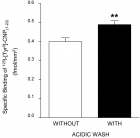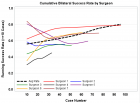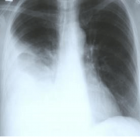Abstract
Case Presentation
Non-surgical Treatment of Verrucous Hyperplasia on Amputation Stump: A Case Report and Literature Review
Sajeda Alnabelsi*, Reem Hasan, Hussein Abdallah and Suzan Qattini
Published: 20 September, 2024 | Volume 8 - Issue 1 | Pages: 015-017
Verrucous hyperplasia is a wart-like lesion that can develop on amputation stumps, often due to poor-fitting prostheses, venous stasis, friction, and bacterial infections. While surgical excision is sometimes necessary for intractable cases, many instances can be managed non-surgically.
We present the case of a 35-year-old male with a slowly growing verrucous plaque on his amputated stump that had caused repeated infections. His prosthesis was loose, allowing the stump to hang loosely inside the socket. After histological confirmation of verrucous hyperplasia, he was advised to change his prosthesis and use compression bandaging. Over 5 months, the lesion resolved without surgery. Early recognition and non-surgical management, including proper prosthetic fit, compression, and hygiene, can often successfully treat verrucous hyperplasia of amputation stumps. This avoids the need for excision in many cases. Patients and clinicians should be aware of this condition and the importance of prosthetic fit and limb care to prevent and treat it.
Read Full Article HTML DOI: 10.29328/journal.adr.1001034 Cite this Article Read Full Article PDF
Keywords:
Prosthesis; Verrucous hyperplasia; Compression; Hygiene; Limb care
References
- Meulenbelt HE, Geertzen JH, Dijkstra PU, Jonkman MF. Skin problems in lower limb amputees: an overview by case reports. J Eur Acad Dermatol Venereol. 2007;21(2):147-55. Available from: https://doi.org/10.1111/j.1468-3083.2006.01936.x
- Dudek NL, Marks MB, Marshall SC, Chardon JP. Dermatologic conditions associated with the use of a lower-extremity prosthesis. Arch Phys Med Rehabil. 2005;86(4):659-63. Available from: https://doi.org/10.1016/j.apmr.2004.09.003
- DesGroseilliers JP, DesJardins JP, Germain JP, Krol AL. Dermatologic problems in amputees. Can Med Assoc J. 1978 Mar 4;118(5):535-7. Available from: https://pubmed.ncbi.nlm.nih.gov/630514/
- George NM, George OT. Warty lesion over amputated stump. J Skin Stem Cell. 2021;8(2). Available from: https://brieflands.com/articles/jssc-119514
- Bardazzi F, Guareschi E, Savoia F, Varotti E. Verrucous hyperplasia in an amputation stump. G Ital Dermatol Venereol. 2003;138:499-501. Available from: https://www.minervamedica.it/en/journals/Ital-J-Dermatol-Venereol/article.php?cod=R23Y2003N06A0499
- Sharma P, Wadhwan V, Aggarwal P, Sharma A. Oral verrucous hyperplasia versus oral verrucous carcinoma: a clinicopathologic dilemma revisited using p53 as an immunohistochemical marker. J Oral Maxillofac Pathol. 2016 Sep-Dec;20(3):362-368. Available from: https://doi.org/10.4103/0973-029X.190902
- Grover S, Jha M, Sharma B, Kapoor S, Mittal K, Parakkat NK, et al. Verrucous hyperplasia: case report and differential diagnosis. Sultan Qaboos Univ Med J. 2017 Feb;17(1). Available from: https://doi.org/10.18295/squmj.2016.17.01.017
- Dhawan AK, Grover C, Bisherwal K, Arora VK, Tomar R. Verrucous hyperplasia of amputation stump. Indian J Dermatopathol Diagn Dermatol. 2015;2(1):23-24. Available from: https://journals.lww.com/ijdd/fulltext/2015/02010/verrucous_hyperplasia_of_amputation_stump.5.aspx
- Kim CW, Yang SY, Hahm JE, Kim KS, Ha JW, Kim SS. A case of verrucous hyperplasia of amputation stump. Program Book. 2018;70(1):458-459.
Figures:
Similar Articles
-
Non-surgical Treatment of Verrucous Hyperplasia on Amputation Stump: A Case Report and Literature ReviewSajeda Alnabelsi*, Reem Hasan, Hussein Abdallah, Suzan Qattini. Non-surgical Treatment of Verrucous Hyperplasia on Amputation Stump: A Case Report and Literature Review. . 2024 doi: 10.29328/journal.adr.1001034; 8: 015-017
Recently Viewed
-
Prevalence of Risk factors of Non Communicable Diseases amongst Medical Students, Kanpur, Uttar Pradesh, IndiaLakshmi Singh*, Anju Gahlot, Atul Kumar Singh. Prevalence of Risk factors of Non Communicable Diseases amongst Medical Students, Kanpur, Uttar Pradesh, India. J Community Med Health Solut. 2024: doi: 10.29328/journal.jcmhs.1001048; 5: 057-061
-
Neurovascular Shifts, Sensory Sensitivity, and PMDD in Autistic Women: Exploring Blood Flow Redirection, Mood Dysregulation, and Pain Tolerance during MenstruationPiper Hutson, James Hutson*. Neurovascular Shifts, Sensory Sensitivity, and PMDD in Autistic Women: Exploring Blood Flow Redirection, Mood Dysregulation, and Pain Tolerance during Menstruation. J Community Med Health Solut. 2024: doi: 10.29328/journal.jcmhs.1001049; 5: 062-068
-
The Role of Diet Therapy in Reducing the Cardiovascular Disease Risk in a Patient with a Long-Standing and Recurring History of ObesityRangelova L*, Nikolova M. The Role of Diet Therapy in Reducing the Cardiovascular Disease Risk in a Patient with a Long-Standing and Recurring History of Obesity. J Community Med Health Solut. 2024: doi: 10.29328/journal.jcmhs.1001050; 5: 069-071
-
Lecture: “First Aid to the Population in Case of Heat and Sunstroke during Accidents, Catastrophes, Natural Disasters and Terrorist Attacks” of the Subject “Life Safety” for Humanitarian and Technical UniversitiesShapovalov KA1,2*, Shapovalova LA. Lecture: “First Aid to the Population in Case of Heat and Sunstroke during Accidents, Catastrophes, Natural Disasters and Terrorist Attacks” of the Subject “Life Safety” for Humanitarian and Technical Universities. J Community Med Health Solut. 2024: doi: 10.29328/journal.jcmhs.1001042; 5: 008-014
-
Smart Cities and Aging Well: Exploring the Links between Technological Models and Social Models for Promoting Daily Social Interaction for Geriatric CareJocelyne Kiss*, Miguel A Reyes, James Hutson. Smart Cities and Aging Well: Exploring the Links between Technological Models and Social Models for Promoting Daily Social Interaction for Geriatric Care. J Community Med Health Solut. 2024: doi: 10.29328/journal.jcmhs.1001043; 5: 015-022
Most Viewed
-
Feasibility study of magnetic sensing for detecting single-neuron action potentialsDenis Tonini,Kai Wu,Renata Saha,Jian-Ping Wang*. Feasibility study of magnetic sensing for detecting single-neuron action potentials. Ann Biomed Sci Eng. 2022 doi: 10.29328/journal.abse.1001018; 6: 019-029
-
Evaluation of In vitro and Ex vivo Models for Studying the Effectiveness of Vaginal Drug Systems in Controlling Microbe Infections: A Systematic ReviewMohammad Hossein Karami*, Majid Abdouss*, Mandana Karami. Evaluation of In vitro and Ex vivo Models for Studying the Effectiveness of Vaginal Drug Systems in Controlling Microbe Infections: A Systematic Review. Clin J Obstet Gynecol. 2023 doi: 10.29328/journal.cjog.1001151; 6: 201-215
-
Prospective Coronavirus Liver Effects: Available KnowledgeAvishek Mandal*. Prospective Coronavirus Liver Effects: Available Knowledge. Ann Clin Gastroenterol Hepatol. 2023 doi: 10.29328/journal.acgh.1001039; 7: 001-010
-
Causal Link between Human Blood Metabolites and Asthma: An Investigation Using Mendelian RandomizationYong-Qing Zhu, Xiao-Yan Meng, Jing-Hua Yang*. Causal Link between Human Blood Metabolites and Asthma: An Investigation Using Mendelian Randomization. Arch Asthma Allergy Immunol. 2023 doi: 10.29328/journal.aaai.1001032; 7: 012-022
-
An algorithm to safely manage oral food challenge in an office-based setting for children with multiple food allergiesNathalie Cottel,Aïcha Dieme,Véronique Orcel,Yannick Chantran,Mélisande Bourgoin-Heck,Jocelyne Just. An algorithm to safely manage oral food challenge in an office-based setting for children with multiple food allergies. Arch Asthma Allergy Immunol. 2021 doi: 10.29328/journal.aaai.1001027; 5: 030-037

HSPI: We're glad you're here. Please click "create a new Query" if you are a new visitor to our website and need further information from us.
If you are already a member of our network and need to keep track of any developments regarding a question you have already submitted, click "take me to my Query."


















































































































































